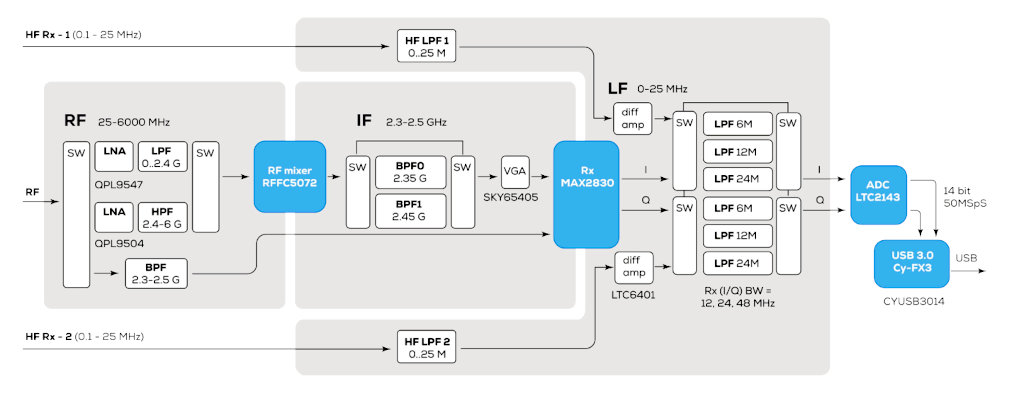It has been about six months since the first Fobos SDR reviews began to appear. There is no question that it is a fine and performant software defined radio for VHF, UHF, and microwave bands. With a good antenna, low noise preamplifier, and computer, the Fobos SDR can very nicely pick up both satellite and terrestrial radio signals.
A lot of reviewers have criticized the Fobos SDR performance on the lower frequencies, from longwave through 25 MHz. In my most humble opinion, critics are wrong about the Fobos SDR; they simply expect it to be something it is not. Defensiveness by RigExpert has not helped much, as they have not made strong arguments for why the SDR is engineered as it is. I will argue here that the Fobos SDR can be the cornerstone of a performant, professional quality general coverage receiving system. The engineers who designed the Fobos SDR left several options open to station builders, who can use external filters, amplifiers, and clocks of the quality necessary to fulfill their needs.
Fobos SDR Design Factors Pertinent to Lowband Reception

One of the most positive aspects of the FobosSDR is its sampling bit depth of 14 bits. That is much better resolution than devices such as the RTL-SDR, making possible a best case dynamic range of 84 dB. More dynamic range and less quantization noise really do make a difference in radio reception quality! Higher resolution does increase the amount of required computer processing resources, hence the need for a high bandwidth data connection between the Fobos SDR and its host computer.
Notice that the Fobos SDR does not have an on-board FPGA to immediately process data from the ADCs. Thus, it is essential to pair the Fobos SDR with a capable computer for the DSP and user interface. This separates the Fobos from receivers like the KiwiSDR, Web-888, or ADALM-Pluto SDR. Also, it is important to use the Fobos with a computer with USB 3.0 connectivity, in order to have enough bandwidth to pass digitized spectrum at the full 50 MHz sampling rate.
The need for computing power and high rate connectivity should not be a deal breaker, but users should know ahead of time about it. There is an advantage to picking one's own level of processing power and picking one's own software: freedom to pick or hop around and try various kinds of DSP and user interfaces. Think about it. The KiwiSDR and Web-888 have a nice interface, but they are unlikely to ever be switched to any other interface. I just don't see a future with them switching to funky new iterations of Gqrx or uSDR.
For reception on HF and lower frequencies, the Fobos SDR does not use a frequency converter ahead of the analog to digital converter (ADC), in contrast to the VHF and higher frequencies. That means the I and Q mixers are available for HF signal inputs. The inputs are separate, and the digital signal data may be kept so, or combined in a useful manner in the user's SDR software.
Possibilities for the use of multiple antenna inputs are:
- Diversity reception - set up for reduced fading on dx signals.
- Diversity reception - set up for direction finding.
- Diversity reception - set up for providing a steerable null against interference.
- Separate inputs for a voting receiver, picking the input with superior signal to noise ratio (SNR).
Direct sampling has the advantage of not requiring signals to be passed through a mixer, where noise and drift from the local oscillator could be imparted to the desired signals. Also, mixers set an upper limit on the overall dynamic range.
Direct sampling reception on the Fobos SDR is configured for signals within the first Nyquist zone, which runs from zero up through 25 MHz when the full 50 MHz sampling rate is used. It is necessary to filter out any signals above 25 MHz, to prevent them from reaching the ADC, where they would get mixed in with desired signals. This is important, and though the Fobos SDR has its own filtering, it would be smart to use an external filter to deeply attenuate any possible interference from higher frequencies.
Sampling rates may be lowered from 50 MHz down to as low as 4 MHz. That greatly lowers the amount of data which needs to be transferred from the Fobos SDR to its host computer. However, using lower sample rates creates a need for low pass RF filters to remove signals outside of the desired Nyquist zone. It is indeed possible to receive signals by undersampling, where the desired signals are in Nyquist zone 3, for example. If you use a reduced sample rate, use an appropriate filter for the frequencies of interest!
While direct sampling SDRs are free of the performance constraints associated with single or double conversion heterodyning, they will always need a clean, precise, and rock stable reference clock for the ADC. Even if the ADC clock is derived from a tunable digital synthesizer or phase locked loop, that clock source needs to be high quality. Currently, manufacturers seem well pleased to build radios with clocks accurate to within one half part per million (0.5 PPM). Clock sources enhanced with satellite timing (GPS / GNSS) can be locked down to within one tenth of a part per million (0.1 PPM) or better. Use an external, satellite based, timing reference if possible!
A prominent gripe of reviewers about the Fobos SDR HF performance is poor sensitivity. I am happy to report that this is an easy performance factor to improve. In fact, I have seen disappointing performance from SDRs with built-in high gain preamplifiers on their antenna inputs. Most often, the gain is either too high, too noisy, or the amplifier overloads too easily.
It is an advantage of Fobos SDR users to have the freedom to pick an external preamplifier with a lower noise figure than most manufacturers would include by default. During a recent group discussion about SDR equipment, a radio operator reported checking the receiver noise figure and measuring 20 dB. Natural noise is quite high in the low and medium frequency bands, but decreases at higher frequencies. On the Fobos SDR, with typical dipoles or wire antennas, natural background tends to fall below the internal receiver noise at frequencies somewhere above 10 MHz, obviously far below the max direct sampling frequency of 25 MHz.
A low noise amplifier (LNA) for the low bands should have a noise figure low enough to pick up the natural noise background at 30 MHz. A noise figure of a "few" dB or less is nescessary, and a gain of at least 15 dB, but no more than 20 dB. There are plenty of commercial units available which have low noise, provide moderate to high gain, and enough dynamic range to not generate troublesome intermodulation products if exposed to strong signals. Be judicious with amplification, though, as excessive gain can still cause problems overloading the receiver ADC, even if the amplifier itself is not being overdriven.
Be especially mindful if you are setting up one of these receivers near a mediumwave or shortwave or shortwave broadcast station, as you may need to lower you amplifier gain to 10 dB or less, or maybe even need to not use an amplifier at all, to prevent ADC overload. If you are having problems due to nearby broadcasters, it might be possible to keep some amplifier gain for those weak signals if you either use a band reject filter to attenuate the broadcaster or install a narrow preselector to more narrowly pass the band you are listening on.
For a broadband, no preselector listening setup, another option for avoiding ADC overload is to use a directional antenna and aim it such that the strong signal falls into a null in the pattern. Loop antennas are quite effective for good general coverage reception, as strong local stations can be deeply nulled with carful aiming.
Bear in mind that a diversity reception / dual ADC feed will require two separate antennas, LNAs, low pass filters, and so forth.

Concluding Remarks
To summarize my points about the suitability of Fobos SDR receivers for HF, mediumwave, and longwave listening: it can work very nicely if external amplification and low pass filtering are used, and consideration is given to handling the situation of being proximate to strong broadcast stations. For weak signal modes, such as WSPR, FT4, and FT8, it is always smart to consider using an external GNSS-disciplined clock reference.
Since the Fobos SDR does not contain an intenal FPGA for digital down conversion, demodulation, and maybe some useful decoders and extra DSP perks, those would need to be accomplished on a separate computer with at least moderate computing power.
The Fobos SDR is primarily a receiver for upper HF through microwave frequencies, but it has nice attributes, such as two separate ADCs which can run simultaneously, and 14 bit ADC sampling. With careful attention to amplification and filtering on the front end, then computing power and software on the back end, the Fobos SDR can do a fine job on the lowbands.
© 2005 - 2025 AB9IL.net, All Rights Reserved.
Written and curated by Philip Collier / AB9IL.
About Philip Collier / AB9IL, Commentaries and Op-Eds, Contact, Privacy Policy and Affiliate Disclosure, XML Sitemap.
This website is reader-supported. As an Amazon affiliate, I earn from qualifying purchases.